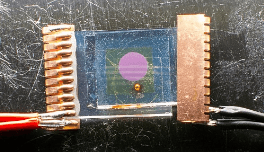Dye-sensitized Solar Cells based on Zinc Compounds
on

Researchers at the University of Basel in Switzerland say they have developed a new approach to producing environmentally sustainable photovoltaic devices. The research team developed a new method for producing dye substances and attaching them to the surface of titanium dioxide nanoparticles. With this they demonstrated that simple dye compounds based on zinc, a readily available metal, can be used.
Dye-sensitized solar cells (DSCs) consist of titanium dioxide, a semiconductor material coated with a colored dye. The dye absorbs sunlight and injects electrons into the titanium dioxide, which ultimately results in a photovoltaic current. Conventional DSCs use ruthenium dyes, but ruthenium is very rare and expensive. The research team showed that dyes made with abundant and relatively inexpensive copper are effective in DSCs, and that low-cost zinc compounds can also be used. Although the new devices are not yet especially efficient, the finding opens the way to new generations of DSCs with previously ignored dye types.
Zinc is not an obvious choice for this application because most zinc compounds are colorless, but in the course of other work related to next-generation lighting devices the researchers discovered new highly-colored organic compounds that could bind to zinc to yield new dyes.


Discussion (0 comments)